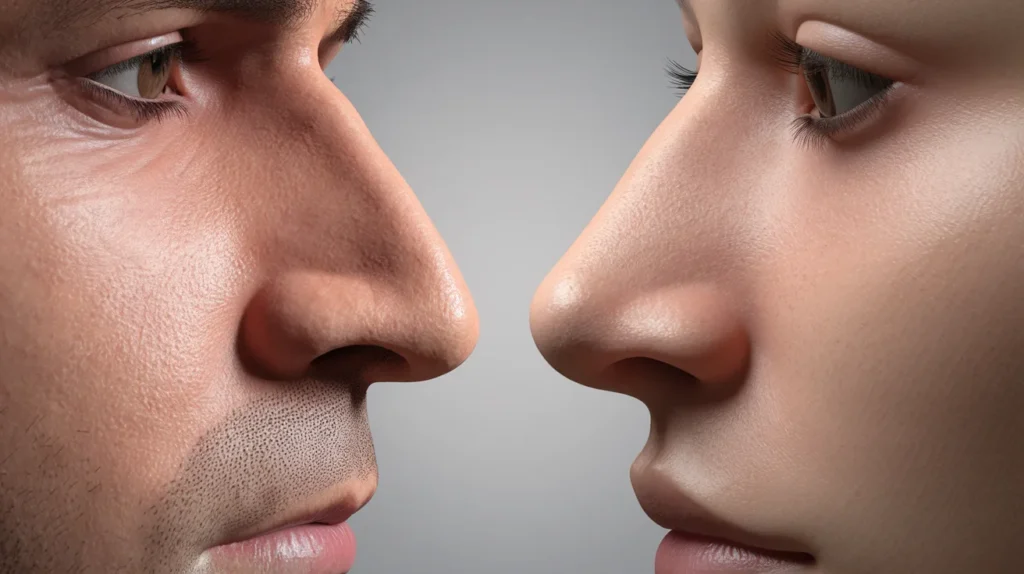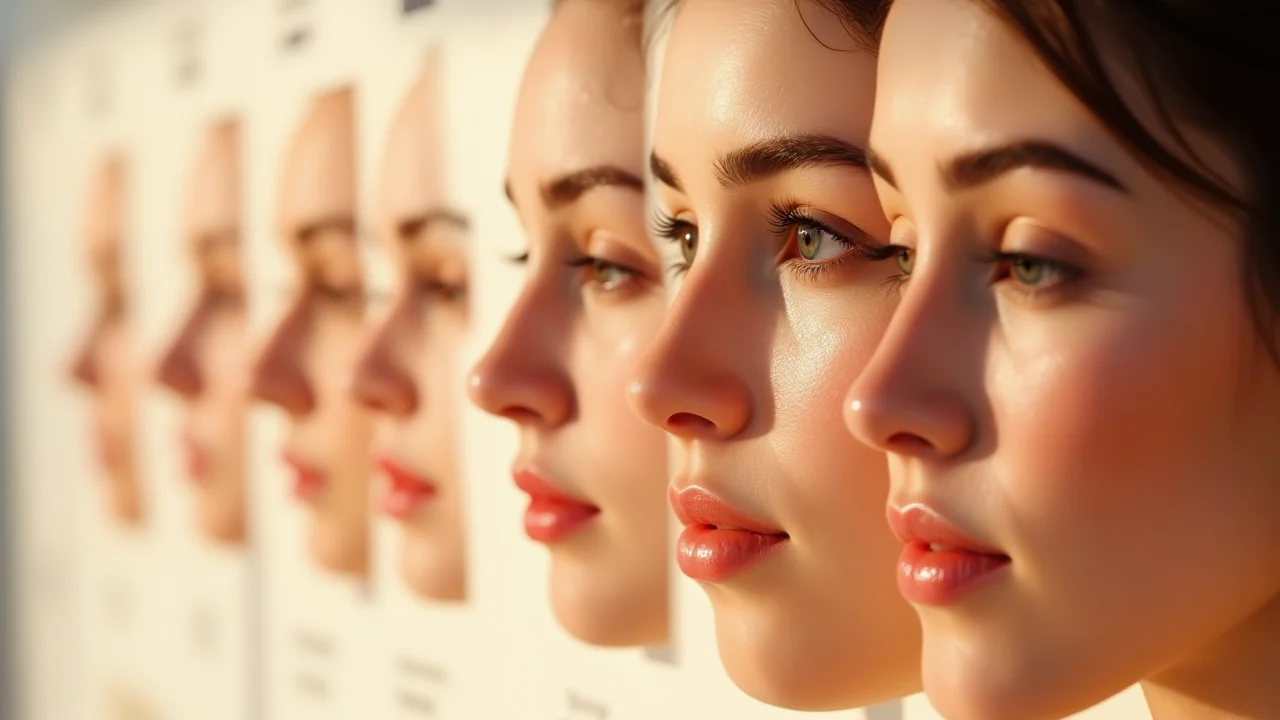Ever stared at a family photo and noticed how different nose shapes tell stories of heritage and identity? From the bold curves of a Roman nose to the delicate slope of a celestial shape, noses are as diverse as the people they belong to. In this guide, we’ll decode nose shape categories, celebrate their cultural roots, and share practical tips to enhance your natural beauty—no surgery required. Let’s begin!
Why Do We Have Different Nose Shapes & Why It’s Matters?

Your nose isn’t just for breathing—it’s a defining feature shaped by genetics, ethnicity, climate, and evolution, making it a true masterpiece of ancestry.
Why Nose Shapes Differ
- Climate Adaptation: Wider nostrils (common in African and tropical regions) help cool air, while narrow bridges (think Nordic noses) warm cold air.
- Genetics: Your DNA decides if you’ll inherit grandma’s button nose or dad’s strong Roman bridge.
- Cultural Pride: For example, Cultural identity and beauty standards shape how nose types are perceived— the Nubian nose is celebrated in Black communities as a symbol of heritage, while the straight “Greek” nose is idolized in Western media, and button noses are associated with youthfulness.
The Importance of Nose Shape
- African ancestry: Wider nostrils and rounded tips (Nubian noses) help regulate warm air.
- Nordic Ancestry: Narrow bridges and smaller nostrils warm and humidify cold air.
- East Asian Ancestry: Lower bridges and wider noses adapt to varying humidity levels.
- Middle Eastern & Mediterranean Ancestry: Prominent, curved noses humidify dry air for better breathing.
- South Asian Ancestry: Medium-width noses balance adaptation for both humid and dry climates.
But here’s the truth: no nose shape is “better” than another. Let’s celebrate diversity!
10 Types of Nose Shapes Explained (With Images)
Below are the most common types of nose shapes, their features, and cultural ties. Use our chart to ID yours!
1. Roman Nose (Aquiline)

- Traits: Prominent, downward-curving bridge.
- Famous Faces: Adam Driver.
- Did You Know?: Named after ancient Roman sculptures!
2. Greek Nose (Straight)

- Traits: No bumps or curves; sleek and narrow.
- Cultural Link: Symbolizes “ideal” beauty in Western cultures.
- Did You Know?: This nose shape is often depicted in ancient Greek sculptures, symbolizing symmetry and classical beauty.
3. Button Nose

- Traits: Petite, rounded tip.
- Celeb Example: Margot Robbie
- Did You Know?: This nose shape is often depicted in baby-faced characters in cartoons and illustrations!
4. Hawk Nose

- Traits: Sharp angle at the bridge.
- Common In: Middle Eastern and Mediterranean regions.
- Celeb Example: Adrien Brody.
- Did You Know?: This nose shape is often associated with strong-willed and determined personalities.
5. The Aquiline Nose

- Traits: A distinctive curved or hooked shape, often giving a regal and strong look.
- Celeb Example: Daniel Radcliffe.
- Did You Know?: The name “aquiline” comes from the Latin word for “eagle,” referencing its beak-like curve.
6. The Snub Nose

- Traits: Small, short, and slightly upturned, often giving a cute and mischievous appearance.
- Celeb Example: Rooney Mara.
- Did You Know?: This nose shape is often linked to a friendly and approachable personality.
7. The Nubian Nose

- Traits: Wider nostrils with a long bridge, often giving a well-defined and expressive look.
- Celeb Example: Beyoncé.
- Did You Know?: This nose shape is commonly celebrated in African heritage and is often associated with beauty and strength.
8. The Upturned Nose

- Traits: A small, slightly upturned tip that creates a delicate and refined look.
- Celeb Example: Emma Stone.
- Did You Know?: Often called the “celestial nose,” this shape is one of the most requested in cosmetic procedures.
9. The Fleshy Nose

- Traits: A rounded, fuller nose with a soft, prominent shape.
- Celeb Example: Mark Ruffalo.
- Did You Know?: This is one of the most common nose shapes, found in people of all backgrounds!
10. The Wide Nose

- Traits: A broad nasal bridge with wide nostrils, often creating a strong and balanced look.
- Celeb Example: Gabrielle Union.
- Did You Know?: This nose shape is highly celebrated in many cultures and often represents a symbol of pride and heritage.
Male vs. Female Nose Shapes: Spot the Differences

Men’s noses are typically larger and broader due to higher muscle mass and oxygen needs. For instance:
- Male-Dominant: Hawk noses (sharp bridge) or fleshy noses.
- Female-Dominant: Celestial noses (soft upturn) or snub noses.
The “Attractive” Nose Myth: What Science Says
While media often pushes a “perfect nose,” studies reveal beauty is in the balance. Noses that align with the Golden Ratio (1:1.618 width-to-length ratio) are deemed attractive—but confidence matters most!
Pro Tip: Use contouring to softly “adjust” proportions (more below).
How to Enhance Different Nose Shapes
Contouring for Your Nose Type
- Wide Nose: Apply a matte bronzer along the sides and highlight the center.
- Product Pick: Anastasia Beverly Hills Contour Kit (buttery blendable shades).
- Long Nose: Sweep bronzer horizontally across the tip.
- Flat nose – Highlight the bridge to add dimension.
Septum Piercing Styles by Nose Shape
- Roman Nose: A vertical spike complements the bold bridge.
- Button Nose: A tiny gold hoop adds whimsy.
- Broader noses can rock bold statement pieces.
- Long, straight nose can carry a bold statement piece.
- Product Pick: Maria Tash Diamond Septum Clicker (luxury meets edge).
Non-Surgical Tweaks
- Nose Fillers: Reshape the bridge or tip temporarily.
- Silicone Correctors: Nose Secret offers invisible daytime shaping.
Cultural Perceptions of Nose Shapes

Different cultures have different beauty ideals when it comes to nose shapes. For example:
- In Western societies, straight and upturned noses are often idealized.
- In Asia, smaller noses with refined bridges are considered beautiful.
- In African cultures, wider noses are seen as a symbol of heritage and beauty.
Conclusion: Your Nose, Your Story
From the regal Roman nose to the playful Button shape, different nose shapes are a testament to human diversity. Whether you’re contouring, piercing, or embracing yours as-is, remember: your nose is a chapter in your unique story. Now, grab a mirror, smile at your reflection, and tag us with your nose shape!
Thinking About a Nose Piercing? Here’s Everything
Eyeglasses Marks on Your Nose? Fixes Here
FAQs
1. Can I change my nose shape without surgery?
Yes! Contouring, fillers, and non-surgical rhinoplasty can alter the appearance of your nose temporarily.
2. What is the most common nose shape?
The fleshy nose is one of the most common nose shapes worldwide.
3. Does nose shape affect personality?
While no scientific evidence links nose shape to personality, cultural beliefs often associate certain nose shapes with traits like strength or elegance.
4. Which nose shape is the most attractive?
It depends on personal and cultural preferences, but straight, symmetrical noses are often considered ideal.
5. How do I choose the right nose piercing for my nose shape?
Smaller noses suit delicate studs, while broader noses can rock bold rings. Always consult a professional piercer for advice.
Other Related Blog
And if you’re interested in learning more tips and tricks for everyday wellness, feel free to check out my other blogs—they cover a wide range of topics to help you feel your best, no matter the situation!
https://whimsyfy.com/best-watch-brands-luxury-to-affordable-under-1000/
https://whimsyfy.com/can-headphones-cause-hair-loss-science-prevention/


